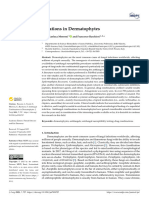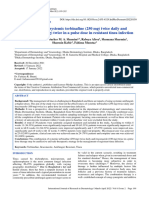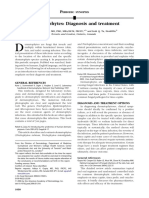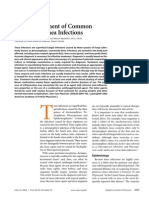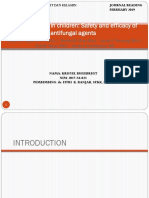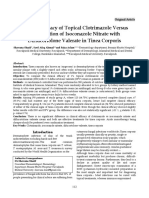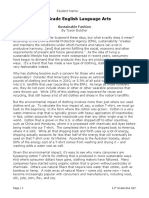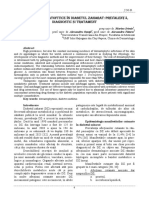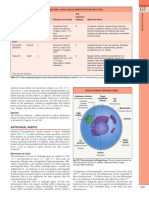Therapy of Common Superficial Fungal Infections: D B. H, L O - Z, J J. W, K R. P & S K. T
Therapy of Common Superficial Fungal Infections: D B. H, L O - Z, J J. W, K R. P & S K. T
Uploaded by
Aji DwijayantoCopyright:
Available Formats
Therapy of Common Superficial Fungal Infections: D B. H, L O - Z, J J. W, K R. P & S K. T
Therapy of Common Superficial Fungal Infections: D B. H, L O - Z, J J. W, K R. P & S K. T
Uploaded by
Aji DwijayantoOriginal Title
Copyright
Available Formats
Share this document
Did you find this document useful?
Is this content inappropriate?
Copyright:
Available Formats
Therapy of Common Superficial Fungal Infections: D B. H, L O - Z, J J. W, K R. P & S K. T
Therapy of Common Superficial Fungal Infections: D B. H, L O - Z, J J. W, K R. P & S K. T
Uploaded by
Aji DwijayantoCopyright:
Available Formats
517
Dermatologic Therapy, Vol. 17, 2004, 517522
Printed in the United States All rights reserved
Copyright Blackwell Publishing, Inc., 2004
DERMATOLOGIC THERAPY
ISSN 1396-0296
Blackwell Publishing, Ltd.
Therapy of common supercial
fungal infections
D
AVID
B. H
UANG
*
,
, L
UIS
O
STROSKY
-Z
EICHNER
, J
ASHIN
J. W
U
, K
ATIE
R. P
ANG
&
S
TEPHEN
K. T
YRING
*
Department of Internal Medicine, Division of Infectious Diseases, Baylor
College of Medicine, Houston, TX,
Department of Internal Medicine, Division
of Infectious Diseases, University of Texas Health Science Center, Houston, TX,
Department of Dermatology, University of California, Irvine, CA,
Department of Dermatology, Wayne State University School of Medicine,
Detroit, MI, and
Department of Dermatology, University of Texas Health
Science Center, Houston, TX and Center for Clinical Studies, Houston, TX
ABSTRACT:
Supercial fungal infections are common, especially onychomycosis, dermatophytoses,
and supercial
Candida
infections. Most supercial fungal infections are treated with topical antifungal
agents unless the infection covers an extensive area or is resistant to initial therapy. Onychomycosis
often requires systemic therapy with griseofulvin, itraconazole, or terbinane. The objective of this
review is to provide the practicing dermatologist with the recommended available therapy for the
treatment of common supercial fungal infections.
KEYWORDS:
fungi, supercial, therapy
Introduction
Supercial fungal infections, such as onycho-
mycosis, dermatophytoses, and supercial
Candida
infections, are common and can be caused by a
myriad of fungi. Many cutaneous fungal infections
may be treated with topical agents. Other fungal
dermatoses may require systemic treatment for
more serious (i.e., difcult to treat organisms,
large infected areas, maceration with secondary
infections, or in immunocompromised individuals)
and relapsing infections to ensure the adequate
presence of a therapeutic agent at the site of
infection. However, the improved cure rates of
topical agents such as azoles, reduced adverse
events prole by topical routes, decreased drug
interactions, and lower cost of these agents make
this therapy a favorable choice in the manage-
ment of supercial fungal infections.
Onychomycosis
Onychomycosis is a fungal infection of the
nger or toe nails. Onychomycosis of the toenails
(FIG. 1) is usually caused by dermatophytes such
as
Trichophyton rubrum
and
Trichophyton menta-
grophytes
. There are four types of onychomycosis:
distal subungual, proximal subungual, white super-
cial, and candidal. Proper diagnosis of the
presence of fungi is necessary prior to initiation
of therapy. Diagnostic methods include use of a
potassium hydroxide preparation, fungal culture,
and/or nail plate biopsy with periodic acid-Schiff
(PAS) stain. Approved topical treatments of ony-
chomycosis have low efcacy rates. Ciclopirox
lacquer is less effective than oral agents such as
itraconazole and terbinane. For onychomycosis
of the toenails, itraconazole may be administered
at 200 mg per day for at least three months or given
No nancial support was received for the following manuscript.
Address correspondence and reprint requests to: David B.
Huang, MD, MPH, Department of Medicine, Division of
Infectious Diseases, Baylor College of Medicine, One Baylor
Plaza, BCM 286, Room N1319, Houston, TX 77030, or
email: dhuang1@bcm.tmc.edu.
Huang et al.
518
as pulse therapy at 200 mg twice a day for one
week per month and no therapy for the remaining
three weeks and treated for three months or
longer (1). For onychomycosis of the ngernails,
itraconazole may be given at 200 mg per day for at
least two months; or at 200 mg twice a day for one
week per month and no therapy for the remaining
three weeks and treated for two months or longer.
Terbinane is also an option for onychomycosis
(1). Terbinane 250 mg per day is given for three
months for toenail infections and two months for
ngernail infections. Treatment with both itracon-
azole and terbinane for longer than one month
requires laboratory monitoring of liver function
tests pretreatment and at four- to eight-week
intervals. Both itraconazole and terbinane
are metabolized by the P-450 3A enzyme system
and may have drug interactions with other medi-
cations. Itraconazole is contraindicated with
cisapride, dofetilide, lovastatin, midazolam,
pimozide, quinidine, simvastatin, and triazolam.
Griseofulvin is also effective for onychomycosis
but must be used for at least four months for
ngernail infections and at least six months for
toenail onychomycosis.
Dermatophytoses
Tinea infections include tinea pedis (feet) (FIG. 2),
tinea barbae (beard area), tinea corporis (general
skin), tinea cruris (groin), tinea capitis (head/scalp)
(FIG. 3), and tinea manuum (limited to the hands).
Tinea infections are caused by three genera of
dermatophytes
Trichophyton
,
Microsporum
and
Epidermophyton
(2). Supercial skin infections
can also be caused by nondermatophytes such
as
Candida
spp. and
Malassezia furfur
in tinea
versicolor. The majority of dermatophytoses are
caused by
T. rubrum.
Most dermatophytes con-
ned to supercial keratinized tissue can be
treated with topical antifungal therapy with a cure
rate greater than 80% (3,4). Topical antifungals
do not penetrate hair or nails so dermatophytes
involving the hair or nails generally need to be
treated with systemic antifungal therapy (5,6). In
addition, systemic antifungal therapy should be
given consideration when lesions involving a large
body surface area fail to clear with repeated treat-
ment using different topical agents (6).
Table 1 lists the indications, formulation, and
frequency of application for common antifungals
used for treatment of dermatophyte infections.
There are limited numbers of studies comparing
the individual agents available. The formulation is
important, as creams or solutions are preferred
for ssured or inamed intertriginous areas and
powders conned to mild lesions of the same
areas. Generally, for tinea corporis and tinea cruris,
topical agents are applied on affected areas and
2 cm beyond once to twice daily for two weeks.
Topical treatment should be given for at least one
week after signs and symptoms resolve.
FIG. 1. Onychomycosis of the toenails.
FIG. 2. Tinea pedis.
Therapy of common supercial fungal infections
519
Combination therapy with antifungals and
corticosteroids may be considered when inam-
mation such as erythema, pruritus, and burning
exist. Clotrimazole-betamethasone (Lotrisone) is
a combination antifungal/steroid agent indicated
for the treatment of dermatophytosis. This ther-
apy has been shown to be efcacious for tinea
cruris and tinea corporis in two randomized con-
trolled studies (7,8). The rst study examined the
efcacy of 1% clotrimazole/0.05% betamethasone
dipropionate versus each of the individual com-
ponents in the treatment of patients with tinea
cruris. The combination antifungal/steroid ther-
apy was found to be more efcacious than either
of the components alone in the clearance of tinea
cruris. The second study examined the efcacy
and safety of 1% clotrimazole/0.05% betametha-
sone dipropionate versus each of its individual
components in patients with tinea cruris or tinea
corporis (8). Each of the three groups received
treatment twice a day for two weeks. At the end
of two weeks, patients in the group receiving
combination antifungal/steroid therapy had an
increased resolution of signs and symptoms asso-
ciated with tinea infection compared to each of its
individual components. All three treatment groups
were found to be safe and there were no reports of
adverse events. Physicians should, however, be
cautious with the long-term use (> two weeks) of
betamethasone (i.e., burning at the area of
application, dryness, itching, thinning of skin,
and striae), especially in the groin area.
Griseofulvin is also used to treat tinea infections.
Griseofulvin is considered the drug of choice for
tinea capitis by some authorities, however, there
are concerns with resistance and toxicities with
this antifungal agent. Griseofulvin is available as
a tablet, a capsule, and in liquid formulation. It is
usually taken once a day or can be taken two to
four times a day. Griseofulvin is usually taken
for two to six weeks for skin infections, four to
eight weeks for hair and scalp infections and four
to eight weeks for foot infections.
Supercial
Candida
infections
Onychomycosis caused by
Candida
spp. may be
treated with itraconazole or terbinane as described
above. For other supercial
Candida
infections
such as cutaneous (FIG. 4) including intertrigo
in skin folds, vaginal or penile lesions, topical
treatment with polyenes (e.g., clotrimazole, micon-
azole, and nystatin), or azoles or systemic treatment
with azoles (i.e., ketoconazole, uconazole, or vori-
conazole) usually are very efcacious (Table 1) (9).
Candida
spp. often affect mucous membranes,
such as oral candidiasis, in immunocompetent and
especially among immunocompromised individ-
uals (FIG. 5). In immunocompetent individuals,
nystatin oral suspension, topical azoles, ucon-
azole single dose orally, or amphotericin B oral
suspension may be used. Among immunocompro-
mised individuals, systematic therapy is preferred
because topical agents are associated with a high
relapse rate (10). Oral therapy with uconazole
(100200 mg/day for two weeks) has a clinical
cure of 84% and mycological cure of 48% in HIV
patients and is likely higher in immunocompetent
individuals (11). With increasing use of uconazole,
uconazole-resistant candidiasis (dened as a MIC
24
g/mL) has been more frequently reported
(12). A gradual increase in minimal inhibitory
concentration (MIC) for
Candida albicans
occurred
in patients who received repeated uconazole
therapy for recurring oropharyngeal candidiasis.
FIG. 3. Tinea capitis with diffuse scaly patches on
the scalp.
Huang et al.
520
Thirteen of 65 (20%) HIV-infected patients devel-
oped in vitro uconazole-resistant
C. albicans
isolates after the repeated use of uconazole for
the treatment of oropharyngeal candidiasis (12).
Itraconazole (200 mg per day for two to four weeks)
may be useful for patients with uconazole-
refractory oral candidiasis (12). Fluconazole and
itraconazole swish and swallow solutions are avail-
able and effective as antifungal therapy for oroph-
aryngeal and supercial
Candida
skin infections.
Itraconazole has a clinical cure of 74% and myco-
logical cure of 40% in HIV patients. In the capsule
formulation, unlike uconazole, itraconazole must
not be taken in patients with hypochlorhydria. The
oral solution of itraconazole has a reliable absorp-
tion and greater bioavailability than the capsule
formulation with a clinical cure of 97% and a
mycological cure of 88% in immunocompromised
Table 1. Antifungal agents available for the treatment of common supercial fungal infections
Indications Antifungal (trade name) Formulation Frequency
Onychomycosis Ketaconazole (Nizoral) Oral 200 mg per day for 23 months
Terbinane (Lamsil) Oral 250 mg per day for 6 weeks for
ngernails and 12 weeks for toenails
Tinea infections Butenane (Mentax) 1% Cream Once or twice daily
Ciclopirox (Loprox, Penlac) 1% Lacquer, lotion, cream Twice daily
Clotrimazole (Lotrimin) 1% Solution, lotion, cream Twice daily
Econazole (Spectazole) 1% Cream Once daily
Griseofulvin (Fulvicin,
Grifulvin, Gris-PEG,
Grisactin, Gristatin)
Oral 500 mg per day for 46 weeks in adults
for tinea capitis, corporis, cruris,
or pedis; and 1020 mg/kg per day
for 68 weeks in children for tinea
capitis, 24 weeks for corporis, and
48 weeks for pedis
Haloprogin (Halotex) Solution, cream Twice daily
Ketaconazole (Nizoral) 2% Shampoo, 1% Cream Twice weekly, once daily
Miconazole (Micatin) 2% Solution, lotion,
cream, powder
Twice daily
Naftine (Naftin) 1% Cream, 1% Gel Once daily
Oxiconazole (Oxistat) 1% Lotion, cream Once or twice daily
Sulconazole (Exelderm) 1% Lotion, cream Once or twice daily
Terbinane (Lamsil) 1% Solution, 1% Cream Once or twice daily
Tonaftate (Tinactin) 1% Solution, lotion,
cream or powder
Twice daily
Oral Candidiasis Nystatin (Mycostatin) Solution 46 ml swish and swallow solution
four times daily for 2 weeks
Amphotericin B (Fungizone) Solution 1 ml oral suspension swish and swallow
four times daily for 2 weeks
Anidulafungin
(LY303366, VER-002)
Intravenous Unknown
Fluconazole (Diucan) Oral In non-AIDS patients, 200 mg single
dose
Itraconazole (Sporanox) Oral In AIDS patients, 200 mg the rst day,
then 100 mg for 2 weeks 200 mg
per day for 2 weeks 50 mg per day
for 10 days
Micafungin (FK463) Intravenous
Voriconazole (Vfend) Oral or intravenous IV: Loading dose 6 mg/kg every
12 hours for 1 day, then maintenance
dose at 4 mg/kg every 12 hours
Oral: > 40 kg body weight: 400 mg orally
every 12 hours for 1 day, then 200 mg
orally every 12 hours; < 40 kg body
weight: 200 mg orally every 12 hours
for 1 day, then 100 mg orally every
12 hours
Therapy of common supercial fungal infections
521
patients (13). Voriconazole is a relatively new anti-
fungal that should be a useful addition to the avail-
able therapies for supercial
Candida
infections
such as oral candidiasis.
Echinocandins are antifungal agents that inhibit
glucan synthesis, a major component of the
fungal cell wall of which Caspofungin (Cancidas) is
the most well known. Echinocandins are effective
against uconazole-resistant strains, have excel-
lent clinical efcacy, and provide improved safety
proles in individuals with supercial
Candida
infections. Two phase III studies are currently
underway to examine the clinical efcacy of anidula-
fungin (LY303366, VER-002) compared to ucon-
azole for the treatment of invasive candidiasis.
Micafungin (FK463), also a member of the echino-
candin class of antifungals, is being developed
for intravenous use and is currently in Phase II
trials (14). Both anidulafungin and micafungin have
a broad spectrum activity against
Candida
spp.,
including azole resistant
C. albicans
and some molds
such as
Aspergillus
spp. (1416).
Severe supercial skin/systemic
fungal infections
Severe supercial and systemic fungal infections
involving the skin often require systemic anti-
fungal therapy in the presence or absence of
topical antifungals. A dedicated section is included
in this issue discussing the available therapy for
severe supercial and systemic fungal infections.
Prevention
In addition to treatment, preventive measures
of fungal infections such as tinea infections
include practicing good personal hygiene; keep-
ing the skin dry and cool at all times; wearing
loose-tting garments made of cotton or synthetic
material; and avoiding sharing towels, clothing, or
hair accessories with infected individuals.
Summary
Supercial fungal infections are common espe-
cially with the involvement of the nails, skin, and
mucous membranes. Onychomycosis accounts
for a great majority of nail disorders. Tinea infec-
tions are the most common fungal infection
worldwide. Ubiquitous candidal organisms are
found in the oral ora of many healthy persons
and result in infection in the presence of certain
host factors or immunodeciency disorders. A
number of antifungals are currently available and
in development for the treatment of supercial
fungal infections. Thus, it is important that both
dermatologists and primary care physicians are
familiar with the many cutaneous fungal infec-
tions and their differential diagnosis to ensure
that appropriate therapy is selected.
References
1. Harrell TK, Necomb WW, Replogle WH, King DS, Noble SL.
Onychomycosis: improved cure rates with itraconazole and
terbinane. J Am Board Fam Pract 2000:
13
: 268273.
2. Weitzman I, Summerbell RC. The dermatophytes. Clin
Microbiol Rev 1995:
8
: 240259.
3. Pierard GE, Arrese JE, Pierard-Franchimont C. Treatment
and prophylaxis of tinea infections. Drugs 1996:
52
: 209224.
FIG. 4. Supercial Candida infection of the epidermis
with erythema, vesicles, and pustules.
FIG. 5. Oropharyngeal candidiasis in a patient with
acquired immunodeciency syndrome (AIDS).
Huang et al.
522
4. Noble SL, Forbes RC, Stamm PL. Diagnosis and manage-
ment of common tinea infections. Am Fam Physician 1998:
58
: 163174.
5. Dei Cas E, Vernes A. Parasitic adaptation of pathogenic
fungi to mammalian hosts. Crit Rev Microbiol 1986:
13
:
173218.
6. Gupta AK, Einarson TR, Summerbell RC, Shear NH. An
overview of topical antifungal therapy in dermatomy-
coses. A North American perspective. Drugs 1998:
55
: 645
674.
7. Wortzel MH. A double-blind study comparing the superi-
ority of a combination antifungal (clotrimazole)/steroidal
(betamethasone dipropionate) product. Cutis 1982:
30
:
258261.
8. Katz HI, Bard J, Cole GW, Fischer S, McCormick GE,
Medansky RS. SCH 370 (clotrimazole-betamethasone
dipropionate) cream in patients with tinea cruris or tinea
corporis. Cutis 1984:
34
: 183188.
9. Rex JH, Walsh TJ, Sobel JD, Filler SG, Pappas PG, Dismukes
WE. Practice guidelines for the treatment of candidiasis.
Infectious Dis Soc Am Clin Infect Dis 2000:
30
: 662678.
10. Smith DE, Midgley J, Allan M, Connolly GM, Gazzard BG.
Itraconazole versus ketoconazole in the treatment of oral
and oesophageal candidosis in patients infected with HIV.
AIDS 1991:
5
: 13671371.
11. Hay RJ. Overview of studies of uconazole in oropharyn-
geal candidiasis. Rev Infect Dis 1990:
12
: S334S337.
12. Ruhnke M, Eigler A, Tennagen I, Geiseler B, Engelmann E,
Trautmann M. Emergence of uconazole-resistant strains
of candida albicans in patients with recurrent oropharyngeal
candidosis and human immunodeciency virus infection.
J Clin Microbiol 1994:
32
: 20922098.
13. Saag MS, Fessel WJ, Kaufman CA, Merrill KW, Ward DJ,
Moskovitz BL. Treatment of uconazole-refractory oroph-
aryngeal candidiasis with itraconazole oral solution in
HIV-positive patients. AIDS Res Hum Retroviruses 1999:
15
:
14131417.
14. Maki K, Morishita Y, Iguchi Y, et al. In vitro antifungal
activity of FK463, a novel water-soluble echinocandin-like
lipopeptide. 38th Interscience Conference on Antimicro-
bial Agents and Chemotherapy 1998. Abstract No. p. 268,
abst. no. F-141.
15. Pfaller MA, Messer SA, Coffman S. In vitro susceptibilities
of clinical yeast isolates to a new echinocandin derivatives,
LY303366, and other antifungal agents. Antimicrob Agents
Chemother 1997:
41
: 763766.
16. Uzun O, Kocagoz S, Cetinkaya Y, Arikan S, Unal S. In vitro
activity of a new echinocandin, LY303366, compared with
those of amphotericin B and uconazole against clinical yeast
isolates. Antimicrob Agents Chemother 1997:
41
: 11561157.
You might also like
- Anshul Nail Disorder ThesisDocument163 pagesAnshul Nail Disorder ThesisAnshul KandholNo ratings yet
- PASSMED MRCP MCQs-DERMATOLOGY PDFDocument53 pagesPASSMED MRCP MCQs-DERMATOLOGY PDFFatima Ema100% (5)
- Diagnosis and Management of Common Tinea InfectionsDocument23 pagesDiagnosis and Management of Common Tinea InfectionsGiovanni AnggastaNo ratings yet
- Diagnosis and Management of Common Tinea InfectionsDocument23 pagesDiagnosis and Management of Common Tinea InfectionsGiovanni AnggastaNo ratings yet
- New Antifungal Agents and New Formulations Against DermatophytesDocument15 pagesNew Antifungal Agents and New Formulations Against DermatophytesJanelle RocoNo ratings yet
- Antifungal Combinations in DermatophytesDocument16 pagesAntifungal Combinations in Dermatophytesaricasvasalb000No ratings yet
- 25.antifungal NigamPKDocument10 pages25.antifungal NigamPKnurulunismuhNo ratings yet
- BPJ Vol 14 No 2 P 1077-1086Document10 pagesBPJ Vol 14 No 2 P 1077-1086Emeray EssenceNo ratings yet
- Mentagrophytes: New and Potential TherapiesDocument2 pagesMentagrophytes: New and Potential TherapiesCrl IwnNo ratings yet
- Fungi: Therapy of Skin, Hair and Nail Fungal InfectionsDocument13 pagesFungi: Therapy of Skin, Hair and Nail Fungal InfectionsAghnia NafilaNo ratings yet
- Antifungal Susceptibility Pattern Against Dermatophytic Strains Isolated From Humans in Anambra State, NigeriaDocument8 pagesAntifungal Susceptibility Pattern Against Dermatophytic Strains Isolated From Humans in Anambra State, NigeriaIJAERS JOURNALNo ratings yet
- Athlete's Foot (Tinea Pedis)Document21 pagesAthlete's Foot (Tinea Pedis)farmasi_hm100% (1)
- Jurnal A Foot in The DoorDocument5 pagesJurnal A Foot in The DoorMonica Dea RosanaNo ratings yet
- Tinea Pedis NewDocument6 pagesTinea Pedis NewRatih Oktaviana YahyaNo ratings yet
- Acral Manifestations of Fungal InfectionsDocument21 pagesAcral Manifestations of Fungal InfectionsanwarNo ratings yet
- Terbinafine: A Position Statement of The NSW Therapeutic Assessment Group IncDocument17 pagesTerbinafine: A Position Statement of The NSW Therapeutic Assessment Group Incedy744No ratings yet
- Steroids PDFDocument35 pagesSteroids PDFPratyusha VallamNo ratings yet
- Homoeopathy An Alternative Therapy For Dermatophyte InfectionsDocument5 pagesHomoeopathy An Alternative Therapy For Dermatophyte InfectionsAman QureshiNo ratings yet
- Treatment of Tinea PedisDocument3 pagesTreatment of Tinea PedisAbi ArellanoNo ratings yet
- Management of Tinea Corporis, Tinea Cruris, and Tinea Pedis: A Comprehensive ReviewDocument19 pagesManagement of Tinea Corporis, Tinea Cruris, and Tinea Pedis: A Comprehensive ReviewYovitaNo ratings yet
- Comparison of The Minimum Fungicidal Concentration of Clotrimazole, Ketoconazole, Miconazole and Terbinafine Against Clinical Isolates of DermatophytesDocument4 pagesComparison of The Minimum Fungicidal Concentration of Clotrimazole, Ketoconazole, Miconazole and Terbinafine Against Clinical Isolates of DermatophytesPratik PawarNo ratings yet
- Comparative Study of Efficacy of Oral Terbinafine Alone and Oral Terbinafine With Topical 8% Ciclopirox Olamine in OnychomycosisDocument7 pagesComparative Study of Efficacy of Oral Terbinafine Alone and Oral Terbinafine With Topical 8% Ciclopirox Olamine in OnychomycosisIJAR JOURNALNo ratings yet
- REFERAT Anti JamurggggDocument20 pagesREFERAT Anti JamurggggGaluh Tiara AkbarNo ratings yet
- Tinea CorporisDocument7 pagesTinea CorporisAziza Ulfie WijayaniNo ratings yet
- Medip, IJORD-1495 ODocument7 pagesMedip, IJORD-1495 OAkshay ShingneNo ratings yet
- A Review of Use of AntibioticsDocument15 pagesA Review of Use of AntibioticsInternational Medical Publisher0% (1)
- Tinea Capitis: Current Review of The Literature: EpidemiologyDocument7 pagesTinea Capitis: Current Review of The Literature: EpidemiologyameliaNo ratings yet
- Dermatophytes Diagnosis and Treatment 2006 Journal of The American Academy of DermatologyDocument6 pagesDermatophytes Diagnosis and Treatment 2006 Journal of The American Academy of DermatologyAjeng Aprilia DewantiNo ratings yet
- Trichophyton Mentagrophytes Type Granular In: Tinea Corporis and Tinea Cruris Caused by Asthma Bronchiale PatientDocument8 pagesTrichophyton Mentagrophytes Type Granular In: Tinea Corporis and Tinea Cruris Caused by Asthma Bronchiale PatientMaisura RaRaNo ratings yet
- 663 1041 1 SMDocument8 pages663 1041 1 SMIvan FirmansyahNo ratings yet
- IJRPP - 14 - 303 Sai Priya MarrapuDocument4 pagesIJRPP - 14 - 303 Sai Priya MarrapuSamuel WilliamsNo ratings yet
- Combined Steroid and AntifungalDocument9 pagesCombined Steroid and AntifungalMega RafikaNo ratings yet
- Topical Treatment of Common Superficial Tinea InfectionsDocument8 pagesTopical Treatment of Common Superficial Tinea InfectionsColate LocoNo ratings yet
- Onychomycosis in ChildrenDocument28 pagesOnychomycosis in ChildrenAstuti Clara SimanjuntakNo ratings yet
- 2003, Vol.21, Issues 3, Antifungal TherapyDocument186 pages2003, Vol.21, Issues 3, Antifungal TherapyRizweta DestinNo ratings yet
- A Case of Chromomycosis Treated by Surgical Therapy Combined With Preceded Oral Administration of Terbinafine To Reduce The Size of The LesionDocument5 pagesA Case of Chromomycosis Treated by Surgical Therapy Combined With Preceded Oral Administration of Terbinafine To Reduce The Size of The Lesionsoekarnohatta94No ratings yet
- Pharmacology AntifungalsDocument24 pagesPharmacology AntifungalsAbdul qadeer100% (1)
- Tugas - Jurnal - Farmakologi 2 Destiara (19032032)Document9 pagesTugas - Jurnal - Farmakologi 2 Destiara (19032032)mgdasNo ratings yet
- Book May 14Document4 pagesBook May 14api-256332754No ratings yet
- TineaDocument2 pagesTineaGail AidNo ratings yet
- Tinea Corporis, Tinea Cruris, Tinea Nigra, and PiedraDocument6 pagesTinea Corporis, Tinea Cruris, Tinea Nigra, and PiedraIsni KhoirunisaNo ratings yet
- Tugas - Jurnal - Farmakologi 2 Destiara (19032032)Document9 pagesTugas - Jurnal - Farmakologi 2 Destiara (19032032)mgdasNo ratings yet
- Bromelain As A Dewormer Natural Plant Cysteine Proteinases As AnthelminticsDocument6 pagesBromelain As A Dewormer Natural Plant Cysteine Proteinases As AnthelminticsproluvieslacusNo ratings yet
- DS 8971746Document10 pagesDS 8971746Waode Rifa AdhianiNo ratings yet
- How Are Odontogenic Infections Best ManagedDocument5 pagesHow Are Odontogenic Infections Best ManagedNurfidini AzmiNo ratings yet
- The ROLE OF HERBAL ANTIFUNGAL AGENTS FOR THE MANAG PDFDocument7 pagesThe ROLE OF HERBAL ANTIFUNGAL AGENTS FOR THE MANAG PDFVenny PatriciaNo ratings yet
- Eritrassm PDFDocument4 pagesEritrassm PDFJeliny Bintan MaisuriNo ratings yet
- Fungal InfectionsDocument9 pagesFungal InfectionsCoral Srinivasa RamaluNo ratings yet
- Tinea CorporisDocument7 pagesTinea CorporisAziza Ulfie WijayaniNo ratings yet
- Therapy Selection For Tinea Corporis and Cruris With CommorbidityDocument9 pagesTherapy Selection For Tinea Corporis and Cruris With CommorbidityShimie Shimie KokobopNo ratings yet
- Chapter 69: Odontogenic Infections Larry J. PetersonDocument14 pagesChapter 69: Odontogenic Infections Larry J. PetersonAhmad EidNo ratings yet
- Antiviral and Anti-Fungal DrugsDocument8 pagesAntiviral and Anti-Fungal DrugsAhmed HadeerNo ratings yet
- 39 B XavierDocument6 pages39 B XavierJatinder Dhillon MehraNo ratings yet
- Senna Alata PDFDocument20 pagesSenna Alata PDFSamantha KilaykiNo ratings yet
- Tinea Infections: Changing Face or Neglected?: Laura Atzori, Laura Pizzatti and Monica PauDocument7 pagesTinea Infections: Changing Face or Neglected?: Laura Atzori, Laura Pizzatti and Monica PauRisma AnjelinaNo ratings yet
- Treatment of Dermatophyte Onychomy-Cosis With Terbinafine (Lamisil) Pulse TherapyDocument2 pagesTreatment of Dermatophyte Onychomy-Cosis With Terbinafine (Lamisil) Pulse TherapyParthMairNo ratings yet
- Fungal Skin PharmacologyDocument12 pagesFungal Skin PharmacologyBrian Lemba 'x-ray'No ratings yet
- Review On Dermatomycosis Jurnal 2Document23 pagesReview On Dermatomycosis Jurnal 2Laela NurrochmahNo ratings yet
- Annular LesionsDocument8 pagesAnnular LesionshpmcentreNo ratings yet
- Tinea FasialisDocument8 pagesTinea FasialisFelix Tortora SekaiNo ratings yet
- GJHS 5 150Document5 pagesGJHS 5 150Wisnu Aditya WardanaNo ratings yet
- Fungal Skin Infections ملزمةDocument6 pagesFungal Skin Infections ملزمةعبدالرحمن طارق عبدالله صالحNo ratings yet
- Clinically Relevant Mycoses: A Practical ApproachFrom EverandClinically Relevant Mycoses: A Practical ApproachElisabeth PresterlNo ratings yet
- YasDocument5 pagesYasAji DwijayantoNo ratings yet
- DAT NeonatalDocument5 pagesDAT NeonatalAji DwijayantoNo ratings yet
- Senin Selasa No. Nama 27 28 P S M P S M 1 Rio 2 Aurora 3 Feni 4 Aji 5 Ria 6 Tari 7 AtikDocument11 pagesSenin Selasa No. Nama 27 28 P S M P S M 1 Rio 2 Aurora 3 Feni 4 Aji 5 Ria 6 Tari 7 AtikAji DwijayantoNo ratings yet
- Case 1.: .Si: ./1.M./S (",./R6Document2 pagesCase 1.: .Si: ./1.M./S (",./R6Aji DwijayantoNo ratings yet
- ProQuestDocuments 2014-03-22 2Document7 pagesProQuestDocuments 2014-03-22 2Aji DwijayantoNo ratings yet
- Diabetic Retinopathy: An Indian PerspectiveDocument14 pagesDiabetic Retinopathy: An Indian PerspectiveAji DwijayantoNo ratings yet
- Arthropods: Sitti Wahyuni, MD, PHD Dept. Parasitology Dept. Parasitology Hasanuddin UniversityDocument32 pagesArthropods: Sitti Wahyuni, MD, PHD Dept. Parasitology Dept. Parasitology Hasanuddin UniversityAji DwijayantoNo ratings yet
- Congestive Heart FailureDocument2 pagesCongestive Heart FailureAji DwijayantoNo ratings yet
- 8 Foot Exercises For Bunions - Everyday Health EXERCISES CLASS PHYSIODocument12 pages8 Foot Exercises For Bunions - Everyday Health EXERCISES CLASS PHYSIOHassan HassanNo ratings yet
- Tinea Corporis An Updated ReviewDocument12 pagesTinea Corporis An Updated ReviewM Ilham FadillahNo ratings yet
- Dermatofitosis FitzpatrickDocument28 pagesDermatofitosis FitzpatrickFadli IlhamNo ratings yet
- Derma MegatableDocument21 pagesDerma MegatableCoy NuñezNo ratings yet
- Antifungal Drugs 3Document54 pagesAntifungal Drugs 3Mikee MeladNo ratings yet
- TEACHER-Made-Learners-Home-Task Nailcare 3Document4 pagesTEACHER-Made-Learners-Home-Task Nailcare 3Marjune RedondoNo ratings yet
- Lecture 4 Dermatology: DR Khaled SobhyDocument88 pagesLecture 4 Dermatology: DR Khaled SobhyHemkerovner Keresztszegh von Kolowrat-KrakowskyNo ratings yet
- Derma ReviewerDocument22 pagesDerma ReviewerAlyssandra LucenoNo ratings yet
- Erythema Nodosum Associated With Terbinafine Therapy A Case ReportDocument5 pagesErythema Nodosum Associated With Terbinafine Therapy A Case ReportAthenaeum Scientific PublishersNo ratings yet
- TABLE 160-9: Treatment of DermatophytesDocument11 pagesTABLE 160-9: Treatment of DermatophytesIrsa SevenfoldismNo ratings yet
- Superfical and CutaneousDocument53 pagesSuperfical and CutaneousmulatumeleseNo ratings yet
- ANTI FungalDocument7 pagesANTI FungalSteve ShirmpNo ratings yet
- Onychomycosis Treatment and Prevention of Recurrence - 2018Document44 pagesOnychomycosis Treatment and Prevention of Recurrence - 2018Rodrigo Valenzuela MontesNo ratings yet
- Diabetic Foot Ulcer Prevention: An Evidence Based PracticeDocument6 pagesDiabetic Foot Ulcer Prevention: An Evidence Based PracticeHarismaPratamaNo ratings yet
- Kti Word Di Ubah Ke KtiDocument52 pagesKti Word Di Ubah Ke KtiRhaihan Eka SNo ratings yet
- LP1 RO TLE-HE BC G9 Q3.editedDocument10 pagesLP1 RO TLE-HE BC G9 Q3.editedJayNo ratings yet
- Superficial Fungal Disorders of The SkinDocument121 pagesSuperficial Fungal Disorders of The SkinhaniNo ratings yet
- Pharmaceutical Microbiology and Parasitology (PHMP211)Document59 pagesPharmaceutical Microbiology and Parasitology (PHMP211)Crisamor Rose Pareja ClarisaNo ratings yet
- 11th Grade Ela CatDocument17 pages11th Grade Ela CatjtNo ratings yet
- Toenail Fungal Infection: A Case ReportDocument3 pagesToenail Fungal Infection: A Case ReportMediterr J Pharm Pharm SciNo ratings yet
- Fungal InfectionsDocument42 pagesFungal InfectionsleenaloveuNo ratings yet
- Dermatology NotesDocument59 pagesDermatology NotesAbdullah Matar Badran50% (2)
- Infecţiile Dermatofitice În Diabetul Zaharat: Prevalenţă, Diagnostic Şi TratamentDocument7 pagesInfecţiile Dermatofitice În Diabetul Zaharat: Prevalenţă, Diagnostic Şi TratamentVlad DovganiucNo ratings yet
- Anti FUNGAL Drugs PDFDocument70 pagesAnti FUNGAL Drugs PDFHester Marie SimpiaNo ratings yet
- Infectious DermatologyDocument206 pagesInfectious DermatologyAaron Christian Earl VillosoNo ratings yet
- Onychomycosis: An Updated Review: Recent Patents On Inflammation & Allergy Drug Discovery October 2019Document15 pagesOnychomycosis: An Updated Review: Recent Patents On Inflammation & Allergy Drug Discovery October 2019jungHAENANo ratings yet
- Antifungal Agents: LipopeptidesDocument8 pagesAntifungal Agents: LipopeptidesCristian QuitoNo ratings yet




